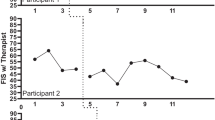Abstract
Using time out to interrupt escalating conflict is an important first step in treating couples and families where physical and emotional abuse is present. Since a time out failure can jeopardize further treatment, developing effective methods for using time out is a therapeutic priority. By interpreting the family's failed attempts as skill deficits, their efforts can be reframed to facilitate their acceptance of new time out methods. These methods are integrated into a model which outlines six hierarchical levels of supplemental control needed to inhibit destructive behavior. The model provides guidelines and establishes incentives for developing a time out strategy appropriate to the family's current level of control. It is designed to guide therapists in helping families strengthen their skills and choose an alternative time out strategy when an initial method fails.
Similar content being viewed by others
References
Beck, A. (1988).Love is Never Enough, Harper & Row, New York.
Bedrosian, R. C. (1982). Using cognitive and systems intervention in the treatment of marital violence. In Barnhill, L. (ed.),Clinical Approaches to Family Violence, Aspen, Rockville, MD, pp. 117–138.
Brantner, J. P., and Doherty, M. A. (1983). A review of timeout: A conceptual and methodological analysis. In Axelrod, S., and Apsche, J. (eds.),The Effects of Punishment on Human Behavior, Academic Press, New York, pp. 87–132.
Clark, H. B., Rowbury, T., Baer, A. M., and Baer, D. M. (1973). Timeout as a punishing stimulus in continuous and intermittent schedules.J. Appl. Behav. Anal. 6: 443–455.
Deschner, J. P. (1984).The Hitting Habit: Anger Control for Battering Couples, Free Press, New York.
Deschner, J., and McNeil, J. (1986). Results of anger control training for battering couples.J. Fam. Viol. 1: 111–120.
Edleson, J. (1984). Working with men who batter.Social Work 29: 237–242.
Ellis, A. (1974). Techniques of handling anger in marriage.J. Marr. Fam. Counsel. 2: 305–315.
Ford, J. E. and Ford, A. V. (1980). Effects of timeout from auditory reinforcement on two problem behaviors.Ment. Relard. 18: 299–303.
Geller, J., and Walsh, J. (1977). A treatment model for the abused spouse.Victomology 2: 627–632.
Goldstein, A., and Glick, B. (1987).Aggression Replacement Training, Research Press, Champaign, IL.
Mantooth, C., Geffner, R., Franks, D., and Patrick, J. (1987).Family Preservation: A Treatment Manual for Reducing Couples Violence, Family Violence Research Program, Tyler, TX.
Margolin, G. (1979). Conjoint marital therapy to enhance anger management and reduce spouse abuse.Am. J. Fam. Ther. 7: 13–23.
Nelson, D. M., and Rutherford, R. B. (1983). Timeout revisited: Guidelines for its use in special education.Except. Ed. Quart. 3: 56–57.
Patterson, G., Reid, J., Jones, R., and Congor, R. (1974).Families with Aggressive Children, Castalia Publishing, Eugene, OR.
Plummer, S., Baer, D. M., and LeBlanc, J. J. (1977). Functional considerations in the use of procedural timeout and an effective alternative.J. Appl. Behav. Anal. 9: 55–64.
Sherman, L. W., and Berk, R. A. (1984).The Minneapolis Domestic Violence Experiment, Police Foundation, Washington, DC.
Solnick, J. V., Rincover, A., and Peterson, C. R. (1977). Determinants of the reinforcing and punishing effects of timeout.J. Appl. Behav. Anal. 10: 415–428.
Sonkin, D. J., and Durphy, M. (1982).Learning To Live Without Violence: A Handbook for Men, Volcano Press, San Francisco.
Taylor, J. (1984). Structured conjoint therapy for spouse abuse.Social Casework 65: 11–18.
Walker, L. E. (1979).The Battered Woman, Harper & Row, New York.
Wiedman, A. (1986). Family therapy with violent couples.Social Casework 67: 211–218.
Weiss, R., and Birchler, G. (1978). Adults with marital dysfunction. In Herson, M., and Bellack, A. (eds.),Behavior Therapy in the Psychiatric Setting, Williams & Wilkins, Baltimore.
Author information
Authors and Affiliations
Rights and permissions
About this article
Cite this article
Veenstra, G.J., Scott, C.G. A model for using time out as an intervention technique with families. J Fam Viol 8, 71–87 (1993). https://doi.org/10.1007/BF00986994
Issue Date:
DOI: https://doi.org/10.1007/BF00986994




